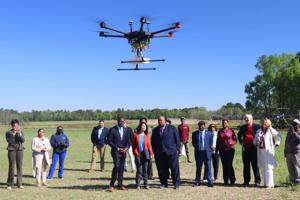
Those chickpeas in your hummus could mean a lot for the future of South Carolina farming.
That was part of the message U.S. Deputy Secretary of Agriculture Xochitl Torres Small received Thursday as she visited South Carolina State University and its Public Service and Agriculture (PSA) division’s Research and Demonstration Farm in Olar.
As Small toured the 200-acre farm, extension agronomist Dr. Nana Kusi showed Small the farm’s chickpea field, which his team is using to research the viability of chickpeas as a cover crop for local farmers to grow in the offseason while also providing a commodity they can market to consumers.
SC State demonstrates the use of AI and drone technology in agriculture for U.S. Deputy Secretary of Agriculture Xochitl Torres Small at the u…
Small said she is pleased to see the university’s climate-smart research on the impact of cover crops can have on reducing carbon emissions while also supporting small farmers.
“It’s also exciting just to get to see the research that’s being done on new potential crops, when it comes to the chickpea for example, and finding the best way to grow it, which can be then shared with farmers and support South Carolina’s economy,” she said in a briefing with regional news reporters at the farm.
People are also reading…
Using a specially outfitted drone, Dr. Joe Mari Maja, SC State senior researcher and director for the Center of Applied Artificial Intelligence for Sustainable Agriculture, also demonstrated for Small the university’s artificial intelligence (AI) applications in agriculture and how they can provide farmers with critical information about their status of their crops.
Extension agronomist Dr. Nana Kusi, right, discusses chickpea cultivation research at the SC State Research & Demonstration Farm with Depu…
“When it comes to research in supporting agriculture, it’s crucial that we take these new emerging technologies,” she said. “President Biden has been clear that when it comes to AI, we’ve got to make sure we’re developing it in ways that support farmers and people all across the country – to invest in new ways of growing and make sure people get a fair share of the food dollar for the work that we do.”
Small was asked what makes SC State special among universities with agricultural missions.
“South Carolina State is one of the few recipients of a Partnership for Climate-Smart Commodities grant,” Small said. “What’s so important about what they’re doing – when I heard them talking about it, they talked about farmers and the impact it will have on farmers.”
SC State has two USDA-funded Climate-Smart initiatives:
Farmers are uncertain as spring planting season opens. Corn prices are down, leaving many to consider reducing acreage and adding peanuts, soy…
- The first of those is a $70 million USDA investment into a partnership between Clemson and SC State to provide incentives to farmers in South Carolina to implement selected climate-smart production practices.
- The second is a $4.5 million USDA Natural Resources Conservation Service grant that will facilitate a partnership between SC State 1890 Research & Extension, Mixon Seed and the South Carolina Black Farmer Coalition for climate-smart initiatives. The funding will be used to educate and train South Carolina’s small and minority farmers and producers in climate-smart practices.
“When it comes to investing in America, investigating in our nation’s farmers is crucial. President Biden is working hard to make sure that the investments reach the people on the ground, reach small growers all across South Carolina and reach partners like South Carolina State University,” Small said.
Following her tour at the farm in Olar, the deputy secretary made her way to SC State’s main campus in Orangeburg, where she met with leaders and faculty members about the USDA’s partnerships with the university. She also engaged with SC State’s 1890 Ag Innovation Scholars, students who will fill roles in the nation’s agricultural industry.
“As deputy secretary for USDA, I spend a lot of time thinking about the future of agriculture and the future of USDA’s workforce,” Small said. “It is so exciting to get to meet that future today when it comes to the 1890 scholars.
“One of the things we’re going to be talking with them about is what they see for the future of agriculture and how we can better invest in them to prepare for that,” she said.
Small’s visit to SC State came on the heels of Agriculture Secretary Tom Vilsack’s visit in December, when he participated in a summit on campus with various stakeholders in South Carolina agriculture, including government leaders, growers, farmers and ranchers.
#lee-rev-content { margin:0 -5px; } #lee-rev-content h3 { font-family: inherit!important; font-weight: 700!important; border-left: 8px solid var(–lee-blox-link-color); text-indent: 7px; font-size: 24px!important; line-height: 24px; } #lee-rev-content .rc-provider { font-family: inherit!important; } #lee-rev-content h4 { line-height: 24px!important; font-family: “serif-ds”,Times,”Times New Roman”,serif!important; margin-top: 10px!important; } @media (max-width: 991px) { #lee-rev-content h3 { font-size: 18px!important; line-height: 18px; } } #pu-email-form-business-email-article { clear: both; background-color: #fff; color: #222; background-position: bottom; background-repeat: no-repeat; padding: 15px 0 20px; margin-bottom: 40px; border-top: 4px solid rgba(0,0,0,.8); border-bottom: 1px solid rgba(0,0,0,.2); display: none; } #pu-email-form-business-email-article, #pu-email-form-business-email-article p { font-family: -apple-system, BlinkMacSystemFont, “Segoe UI”, Helvetica, Arial, sans-serif, “Apple Color Emoji”, “Segoe UI Emoji”, “Segoe UI Symbol”; } #pu-email-form-business-email-article h2 { font-size: 24px; margin: 15px 0 5px 0; font-family: “serif-ds”, Times, “Times New Roman”, serif; } #pu-email-form-business-email-article .lead { margin-bottom: 5px; } #pu-email-form-business-email-article .email-desc { font-size: 16px; line-height: 20px; margin-bottom: 5px; opacity: 0.7; } #pu-email-form-business-email-article form { padding: 10px 30px 5px 30px; } #pu-email-form-business-email-article .disclaimer { opacity: 0.5; margin-bottom: 0; line-height: 100%; } #pu-email-form-business-email-article .disclaimer a { color: #222; text-decoration: underline; } #pu-email-form-business-email-article .email-hammer { border-bottom: 3px solid #222; opacity: .5; display: inline-block; padding: 0 10px 5px 10px; margin-bottom: -5px; font-size: 16px; } @media (max-width: 991px) { #pu-email-form-business-email-article form { padding: 10px 0 5px 0; } } .grecaptcha-badge { visibility: hidden; }
